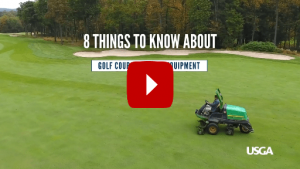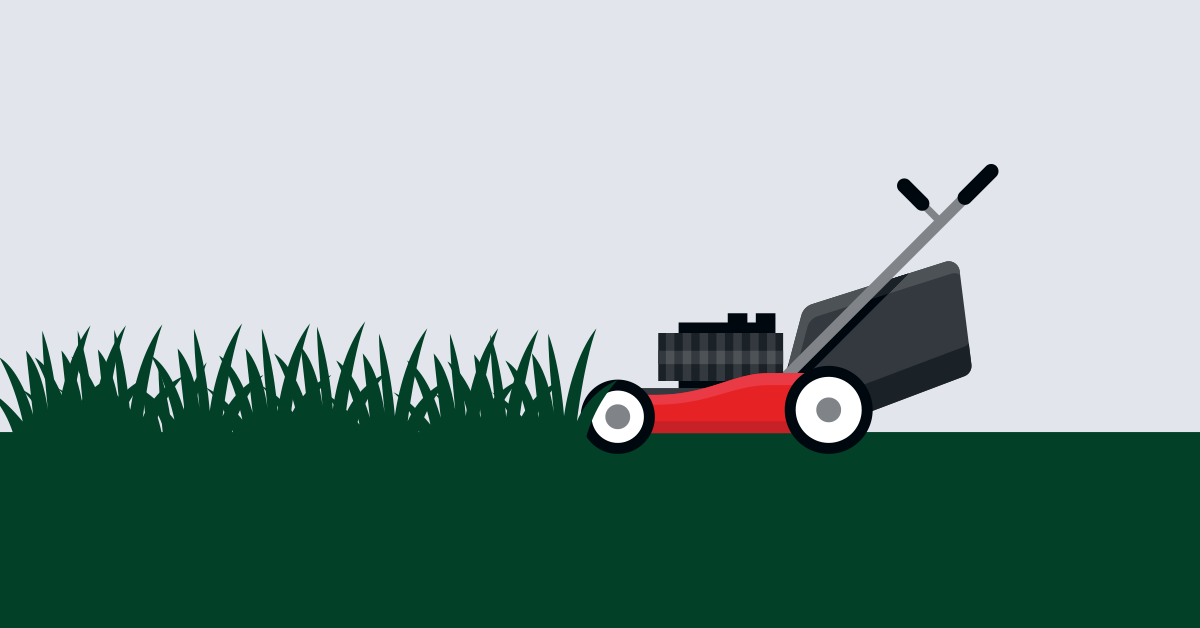
Golfers have many options in where to tee it up these days, and courses with a diverse collection of specialized equipment, vehicles, and tools have an advantage over facilities whose budget may not support such a variety of resources. After all, pristine golf course conditions can go a long way in filling your tee sheet. Most people, even many golfers, think it’s all mowers, and having one or two is all you need.
However, there’s much more needed than that, and every member of the maintenance staff plays a vital role in meeting golfers’ expectations. In fact, golf course superintendents have never utilized as many specialized pieces of equipment and tools as they do now. With advances in technology and increased environmental concerns, golf courses are utilizing electric and hybrid equipment, as well as automated machinery to get the job done.
Discover how shifting your operation online can give you an edge over the competition while simplifying day-to-day operations.How To Bring Your Golf Course Online
Mowing Equipment
Mowing often consumes the greatest portion of a maintenance team’s day-to-day operations. Because most mowers are intended for specific parts of the golf course, multiple types of mowers are needed in the course’s daily maintenance. The greens mower is arguably the most important component in the maintenance superintendent’s arsenal because golfers often judge their experience upon putting green conditions more than any other aspect of the course. As such, the surface of the putting green is the most thoroughly-managed part of the course.
Putting Greens Mowers
Greens mowers come in the walk-behind and riding varieties. Each has its pros and cons, and golf course superintendents must gauge their needs when deciding which type to use. There is sometimes debate among course superintendents, but the consensus is that walking mowers provide a more precise cut than their counterparts. Riding mowers, however, get the job done in a fraction of the time.
Greens mowers, regardless of how they are operated, use reels, as opposed to the rotary mowers most of us have at home. Not only do greens mowers have more blades, but they also use a scissoring action against a fixed bedknife, one of three primary parts in a cylinder cutting unit. The cut is more precise and provides an even putting surface for a consistent roll of the golf ball.
With the average height of putting greens being lowered in recent years from one-quarter inch to one-eighth inch or lower, properly calibrating one’s greens mowers can make a noticeable difference. The quantity of mowers needed depends upon how they’re used. For facilities using a two-tee reservation system, both nines will need to be cut simultaneously, doubling the number of mowers needed.
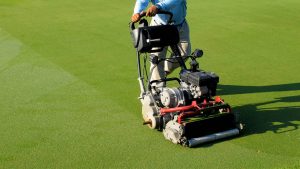
Greens Collar Mowers
With the grass length slightly higher around the collar of the green, a second mower is required. Contrary to greens mowers, collar mowers are more likely to be the walking variety. Many courses will keep their collar length consistent with that of their tee boxes, enabling the same machinery to be utilized for both areas. For playability purposes, many courses are now cutting collars to one-quarter inch.
Tee Mowers
As mentioned, many facilities will assign double duty to their tee and greens collar mowers. One issue that may arise is that most tee mowers used are riding (or triplex) mowers, contrary to what is preferred around the collars. To solve this issue, courses are either widening their collars to accommodate tee mowers or reconsidering the size of their tee boxes to more efficiently utilize the collar mowers. This is another example of what superintendents must consider when gauging their equipment needs.
Approach Mowers
Factors like staffing, approach size, and course maintenance standards dictate what approach mowers are best for each facility. With such tight areas, many courses are using walking mowers to alleviate the damage sometimes caused by the turning of triplex mowers.
Fairway Mowers
Bigger in size to accommodate the expansive area they cover, fairway mowers are generally four-wheeled machines with even more cutting units. With the frequency at which fairways are mowed, high-quality equipment is recommended to reduce downtime and maintenance expenses. Big names in the industry like Toro and John Deere are now advancing the prospects of autonomous mowers. Other companies have already put autonomous mowers in place in Canada and Europe, however. The reduction in labour costs goes without saying, but the use of staff time changes once these mowers are incorporated, as they have to be moved with the completion of each designated area.
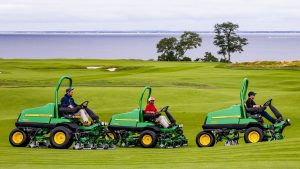
Intermediate Rough Mowers
Not all courses put an intermediate layer of rough in place, as it warrants yet another mower and also exhausts a greater number of man-hours. Again, the superintendent must make these decisions based on staff size, budget, and expected results. The contrast between fairway and rough is desired at many high-end facilities, but is often considered unnecessary or simply not viable at many other courses.
Primary Rough Mowers
This is the largest area covered by your maintenance staff. These mowers can be reel- or rotary-based, though the latter is more common. Seen as lower on the superintendent’s list of priorities, this area of rough is often tackled later in the day after the more critical, greens, collar, approach, and fairways have been attended to. The frequency of this work can be less strict and will often get done once or twice per week, except those rough areas that surround the greens, which will often be manicured three times weekly.
Cultivation Equipment
Also required for any course is the equipment used for turf cultivation. Much to the dismay of golfers, routine aeration is necessary but is done for several reasons. The most common being to reduce soil compaction, manage thatch and organic matter accumulation, improve water infiltration, promote gas exchange, and provide avenues in the soil for deeper roots. If you’re a golfer reading this, trust your club’s superintendent on this one.

Walk-Behind Aerators
This variety of aerators is used primarily for putting greens, offering flexibility in tine spacing, depth of plugs, and speed of the operation. Walking aerators are also used on collars, approaches, and tee boxes for the same reasons. These models allow tines to be one to two inches apart, contrary to older models that restricted tines to just two to four inches apart. Current models do a considerably more effective job, making the efforts worthwhile for the superintendent and his facility.
Tractor-Mounted Aerators
These aerators are used for larger areas of turf, such as fairways and rough. What used to be done more effectively by walking is now being satisfied by tractor-mounted aerators, thanks primarily to the tine-spacing options of today’s machinery.
Other Aerators
There are a variety of other aerators that provide sufficient depth and offer options in rotating blades and knives that cut into the soil. Many are incorporated to supplement a course’s existing equipment.
Vertical Mowing Units
Vertical mowing is done to eradicate organic thatch buildup on the surface without disturbing the soil below. The depth of cutting can be adjusted based on the desired goals of the process.
Topdressing Equipment
Topdressing is required after the aeration process. Most golf courses will top-dress their greens, collars, and approaches. However, topdressing tees and fairways will depend upon the turfgrass species and soil composition. Topdressing occurs when sand is evenly applied across a turf surface and is done to fill aeration holes. It is also used throughout the growing season to smooth the surface and increase firmness, eradicating organic matter accumulation. Modern topdressing equipment covers a greater area with a consistent amount of sand with each disbursement.
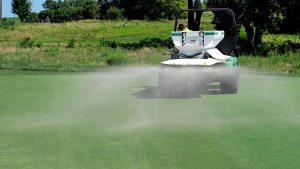
Fertilization and Pest-Management Equipment
As with other processes, the application of fertilizers, herbicides, fungicides, insecticides, or plant growth regulators requires specific equipment. Most of these products are applied in either granular or liquid form and the type of equipment needed hinges on that factor.
Transportation Equipment
Transporting staff, tools, and materials around the course requires utility vehicles. Many of these are lightweight, two-person vehicles that can also tow a greens mower on a trailer. Also needed are more heavy-duty utility vehicles when hauling heavier materials, like sand, gravel, soil, or sod. These units can handle the excessive weight of materials and they are built to last a long time. They also enable staff to go from task to task swiftly, not wasting valuable time between jobs.
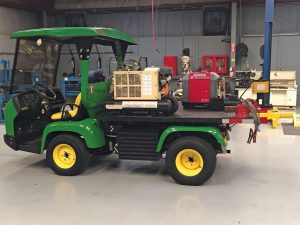
Tractors & Other Large Equipment
When you consider the power needed for most on-course tasks, tractors and other large equipment are vital. A facility will often require several of these costly vehicles, using three or four in the aeration process alone. Without this heavy-duty equipment, many golf course tasks are harder to complete. Backhoes, dump trucks, and pickup trucks help with course maintenance and transportation as well. It really comes down to budget.
Miscellaneous Equipment
Additional equipment required depends upon the expected golf course conditions, the topography of the golf course, and its design and physical features. Mechanical and hand rakes for bunkers and blowers and sweepers are other examples of miscellaneous equipment. Side-to-side rollers, sod cutters, and even hand-pushed rotary lawn mowers are needed, the latter being to maintain smaller areas near the clubhouse.
Specialty Equipment
With technology comes new tools that make golf course maintenance easier and more efficient. A soil moisture meter is one of the newest tools at many golf courses. They allow superintendents to quickly measure the volumetric water content in the soil, and some even monitor salt content. These tools are critical in daily irrigation decisions being made. This equipment is costly, but the return on investment (ROI) is swift.
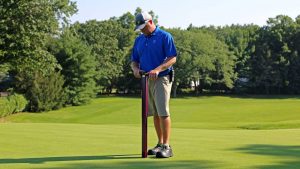
Maintenance & Storage
There are many equipment needs within the maintenance facility, as well. To ensure a consistent cut from your mowers, grinders are required for sharpening and upkeep, and reels must be kept sharp. Of course, protecting equipment from the elements is vital to longevity and reduces repair bills, not to mention enhances performance.
Paying for Your Equipment
Golf course budgets and desired course conditions determine what equipment is utilized. When dealing with a limited budget, like so many facilities do, the greens committee, superintendent and board of directors should prioritize equipment based on their business goals and economic forecasts. They should also weigh the pros and cons of buying versus leasing.
Buying
Buying equipment is a great capital expenditure for any golf facility. Loans help spread payments over several years and avoid huge financial obligations, but accrued interest payments increase the cost over the long term.
Leasing
Leasing typically creates a natural timeline for equipment to be turned over, and with the constant advances in technology, this could be advantageous to your facility.
Having the right equipment is essential
This article should serve as a valuable resource for the common types of equipment, vehicles, and tools needed to care for your golf course. Every facility will require different types and quantities of equipment, so analyze your needs and budget. Network with like facilities and similar course types with comparable budgets, and tap into the expertise of industry leaders.
Do you want to improve your operations and take your golf course to the next level this season? Talk to one of our experts today and discover how Lightspeed Golf can lend a helping hand to your facility.

News you care about. Tips you can use.
Everything your business needs to grow, delivered straight to your inbox.
